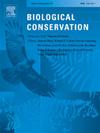European conservation policy needs a clear definition of ‘wolf-dog hybrid’
IF 4.9
1区 环境科学与生态学
Q1 BIODIVERSITY CONSERVATION
引用次数: 0
Abstract
Anthropogenic hybridisation, especially when introgressive through backcrossing into parental species, is a global threat to many wild taxa, including wolves (Canis lupus) interbreeding with dogs (C. familiaris or C. l. familiaris) (i.e., wolf-dog hybridisation, WDH). Despite the Standing Committee of the Bern Convention's recently approved proposal to reduce the protection status of wolves from Appendix II to Appendix III, the assessment of Favourable Conservation Status (FCS) for wolves within the EU Habitats Directive does not consider anthropogenic hybridisation as a separate threat category. Hybrids being increasingly recognised as a relevant threat to European wolves, we advocate that WDH should be considered in assessing their conservation status. However, the lack of a clear and commonly accepted definition of wolf-dog hybrids has been limiting progress on legislation, policy, and conservation management. Therefore, to help mitigate the threat of WDH to wolves, we hereby propose a science-based definition of wolf-dog hybrids as a reference for conservation management. The definition is not intended to prescribe management, which will require case-by-case consideration of various factors including local regulations, conservation priorities, ethics, animal welfare, and human dimensions. It (1) provides an entity for legal and policy efforts, (2) promotes shared and transparent technical standards for hybrid identification, and (3) acknowledges the need for nuanced, population-based management policies. The definition provides an essential first step and an international reference that we envision will help mitigate the threat of WDH to wolves and preserve wolf ecological function.
欧洲动物保护政策需要明确定义“狼狗混血儿”
人为杂交,特别是通过回交进入亲本物种时,是对许多野生分类群的全球性威胁,包括狼(Canis lupus)与狗(C. familiaris或C. l. familiaris)的杂交(即狼狗杂交,WDH)。尽管《伯尔尼公约》常务委员会最近批准了将狼的保护地位从附录II降至附录III的提案,但在欧盟栖息地指令中对狼的有利保护地位(FCS)的评估并未将人为杂交作为一个单独的威胁类别。混血儿越来越被认为是对欧洲狼的相关威胁,我们主张在评估其保护状况时应考虑WDH。然而,缺乏一个明确和普遍接受的狼狗杂交的定义已经限制了立法,政策和保护管理的进展。因此,为了减轻WDH对狼的威胁,我们提出了一个基于科学的狼狗杂交定义,作为保护管理的参考。该定义并不是为了规定管理,这将需要对各种因素进行个案考虑,包括地方法规、保护优先事项、道德、动物福利和人的方面。它(1)为法律和政策工作提供了一个实体,(2)促进混合身份识别的共享和透明技术标准,以及(3)承认有必要制定细致入微的、基于人群的管理政策。该定义提供了重要的第一步和国际参考,我们预计将有助于减轻WDH对狼的威胁,保护狼的生态功能。
本文章由计算机程序翻译,如有差异,请以英文原文为准。
求助全文
约1分钟内获得全文
求助全文
来源期刊

Biological Conservation
环境科学-环境科学
CiteScore
10.20
自引率
3.40%
发文量
295
审稿时长
61 days
期刊介绍:
Biological Conservation is an international leading journal in the discipline of conservation biology. The journal publishes articles spanning a diverse range of fields that contribute to the biological, sociological, and economic dimensions of conservation and natural resource management. The primary aim of Biological Conservation is the publication of high-quality papers that advance the science and practice of conservation, or which demonstrate the application of conservation principles for natural resource management and policy. Therefore it will be of interest to a broad international readership.
 求助内容:
求助内容: 应助结果提醒方式:
应助结果提醒方式:


